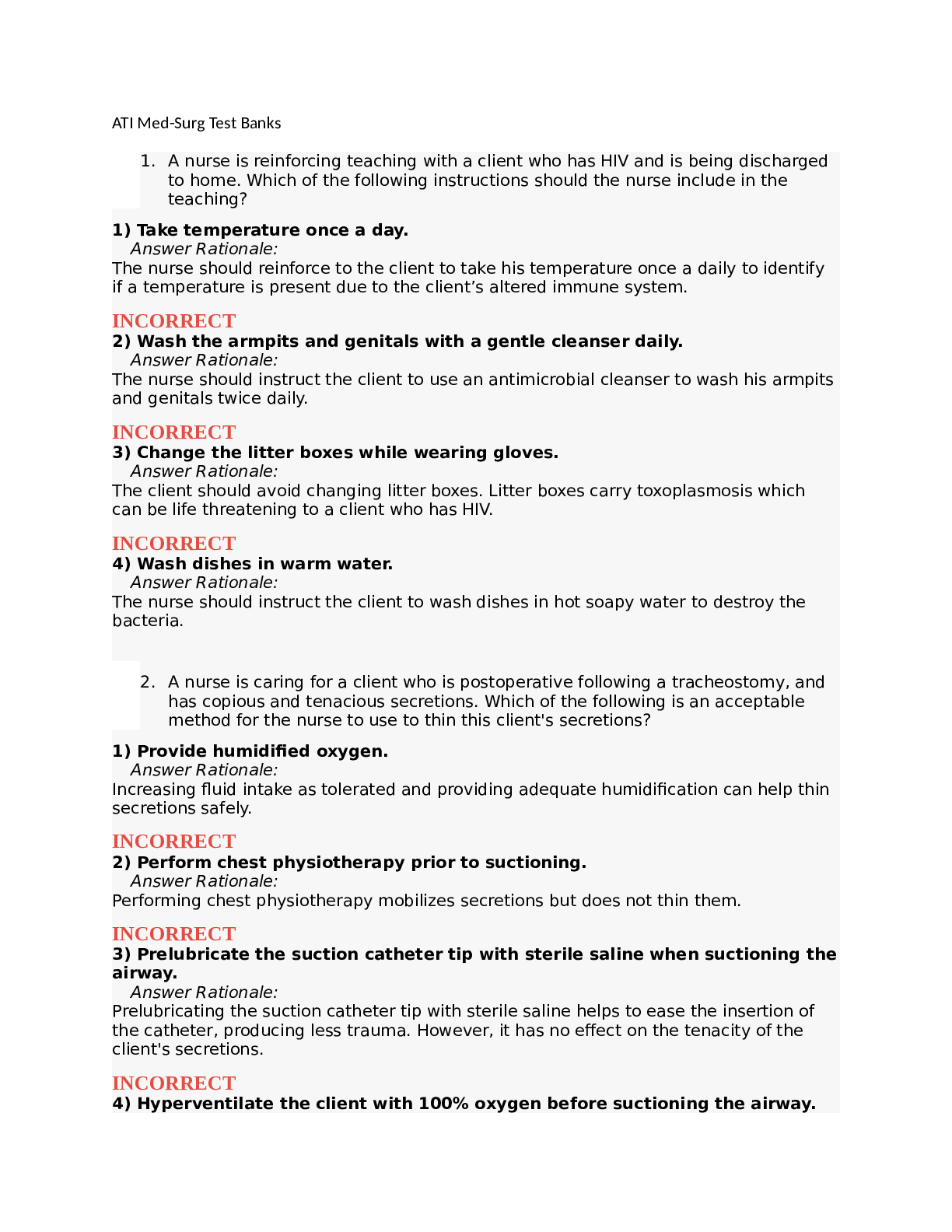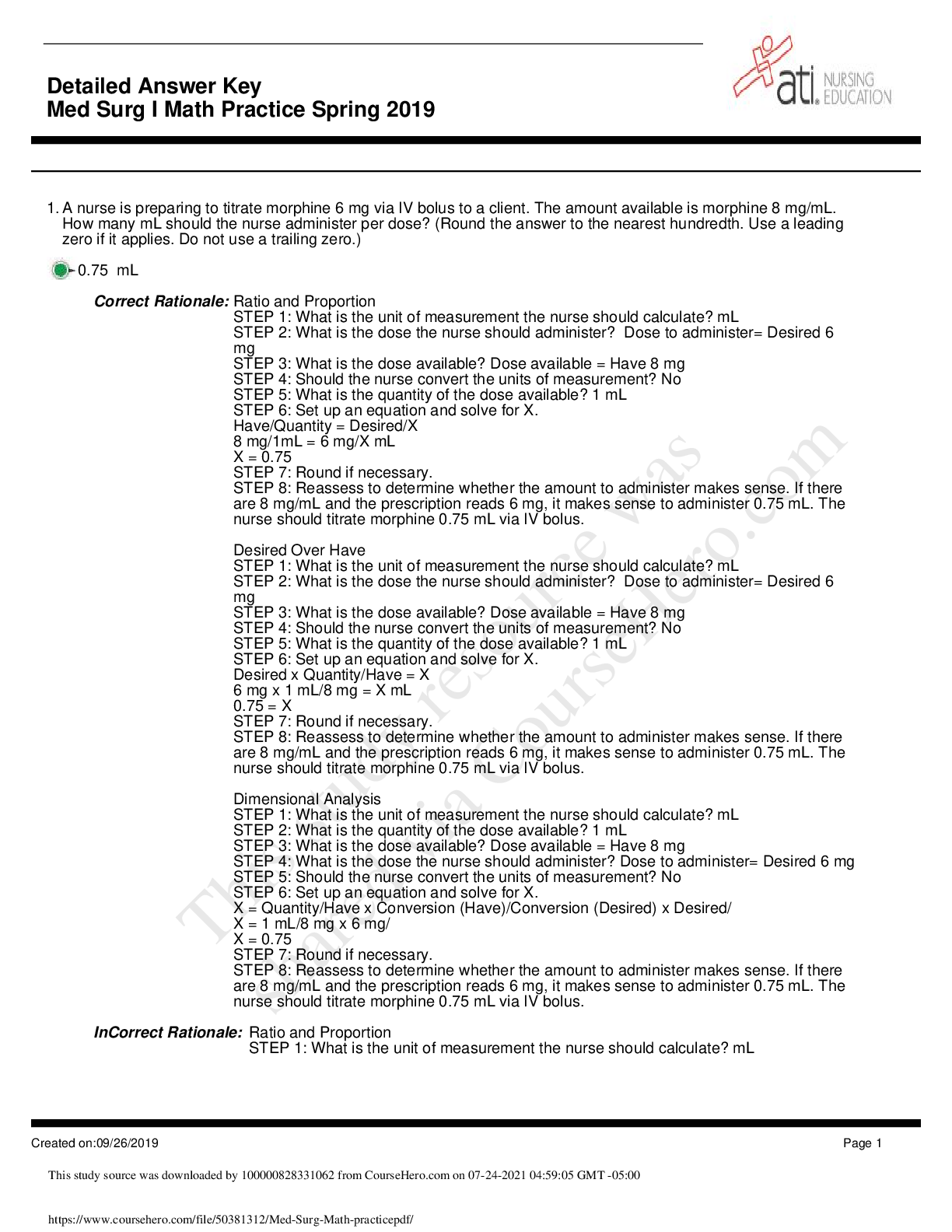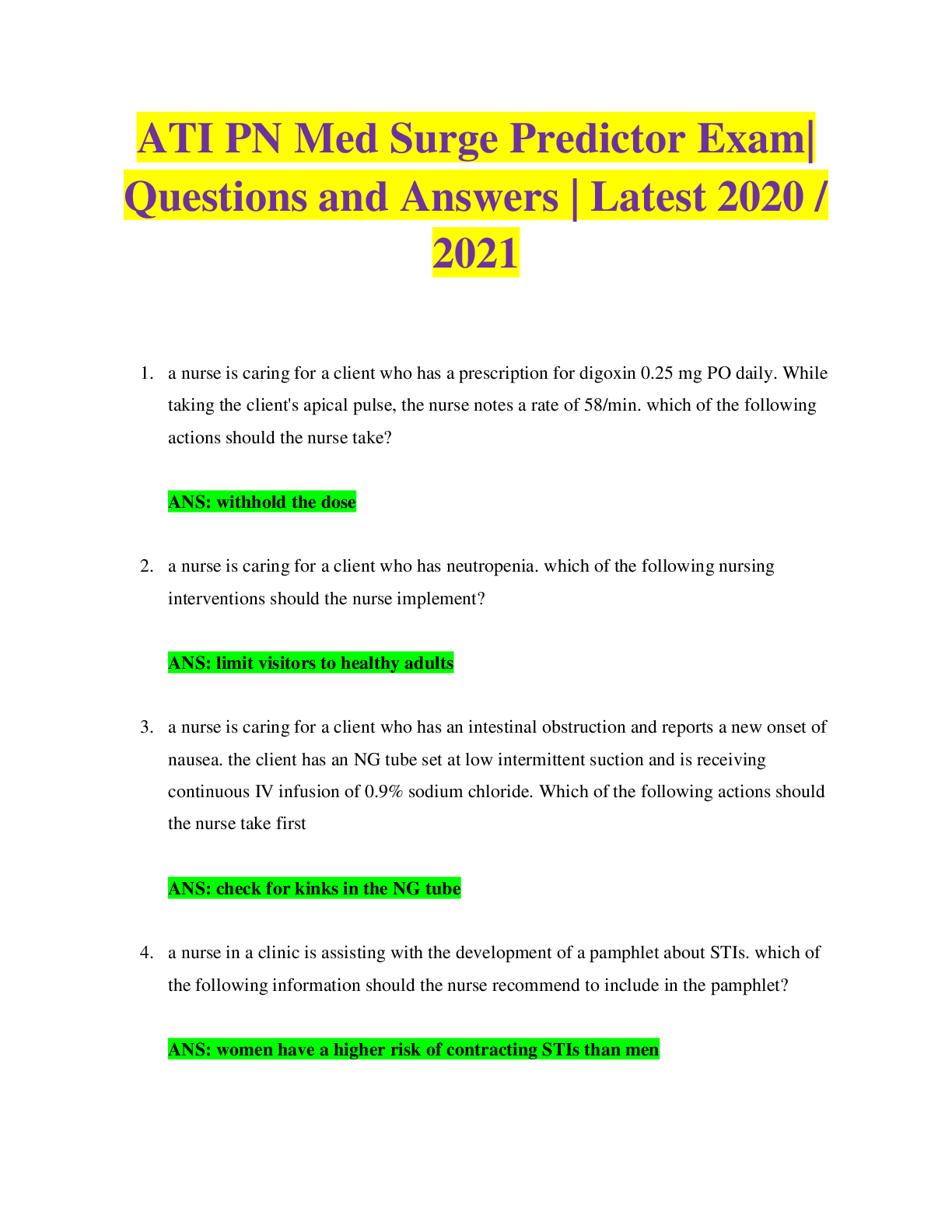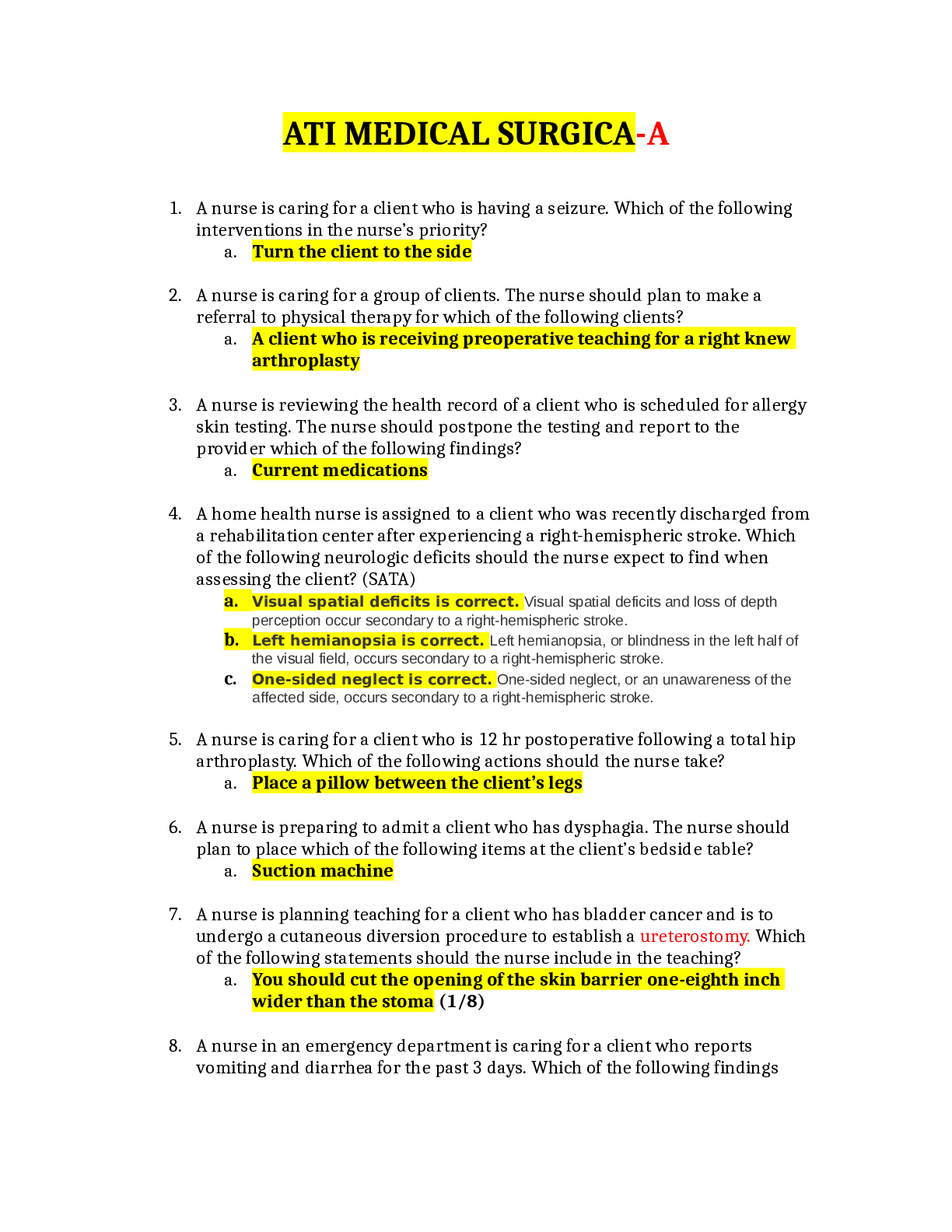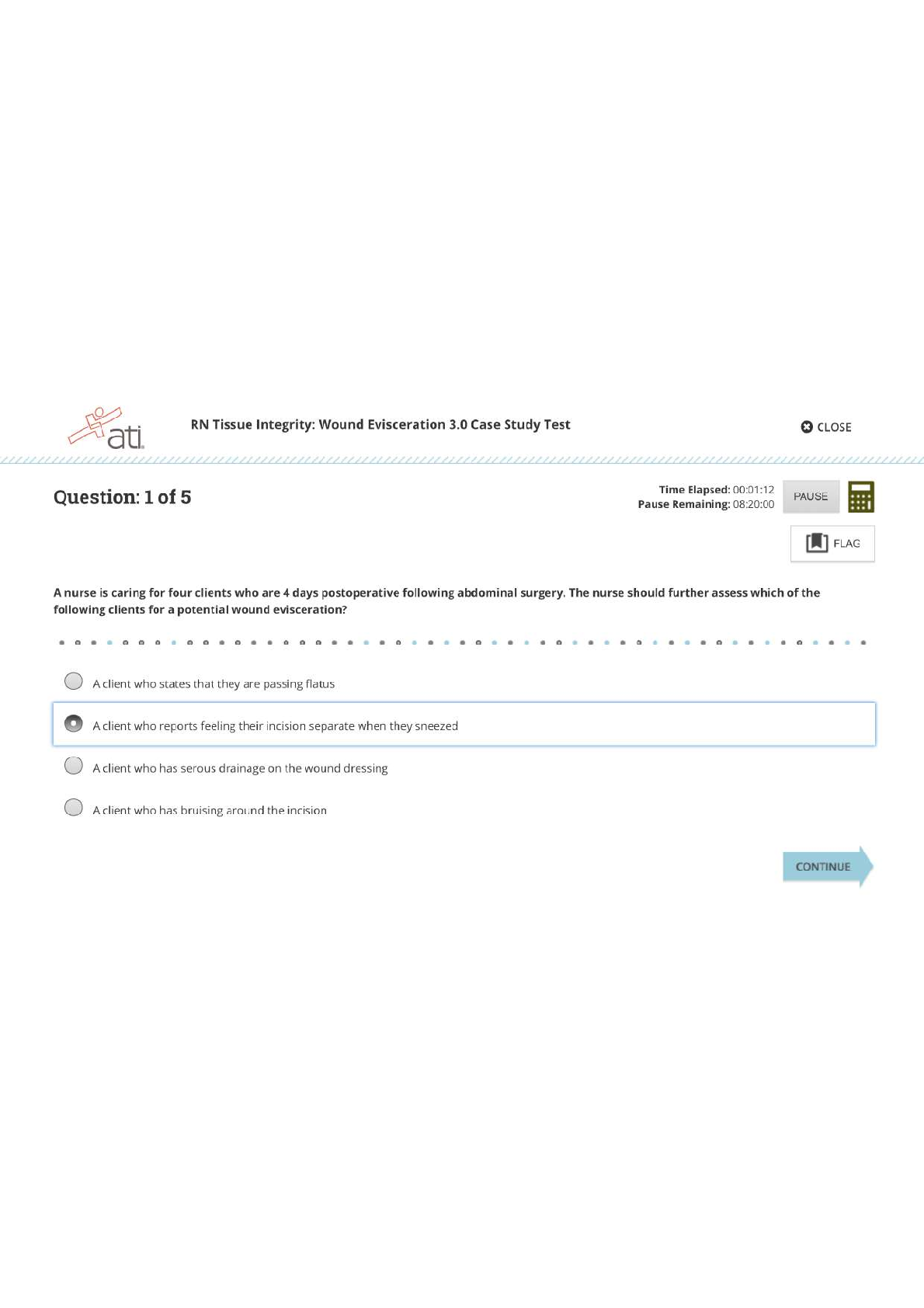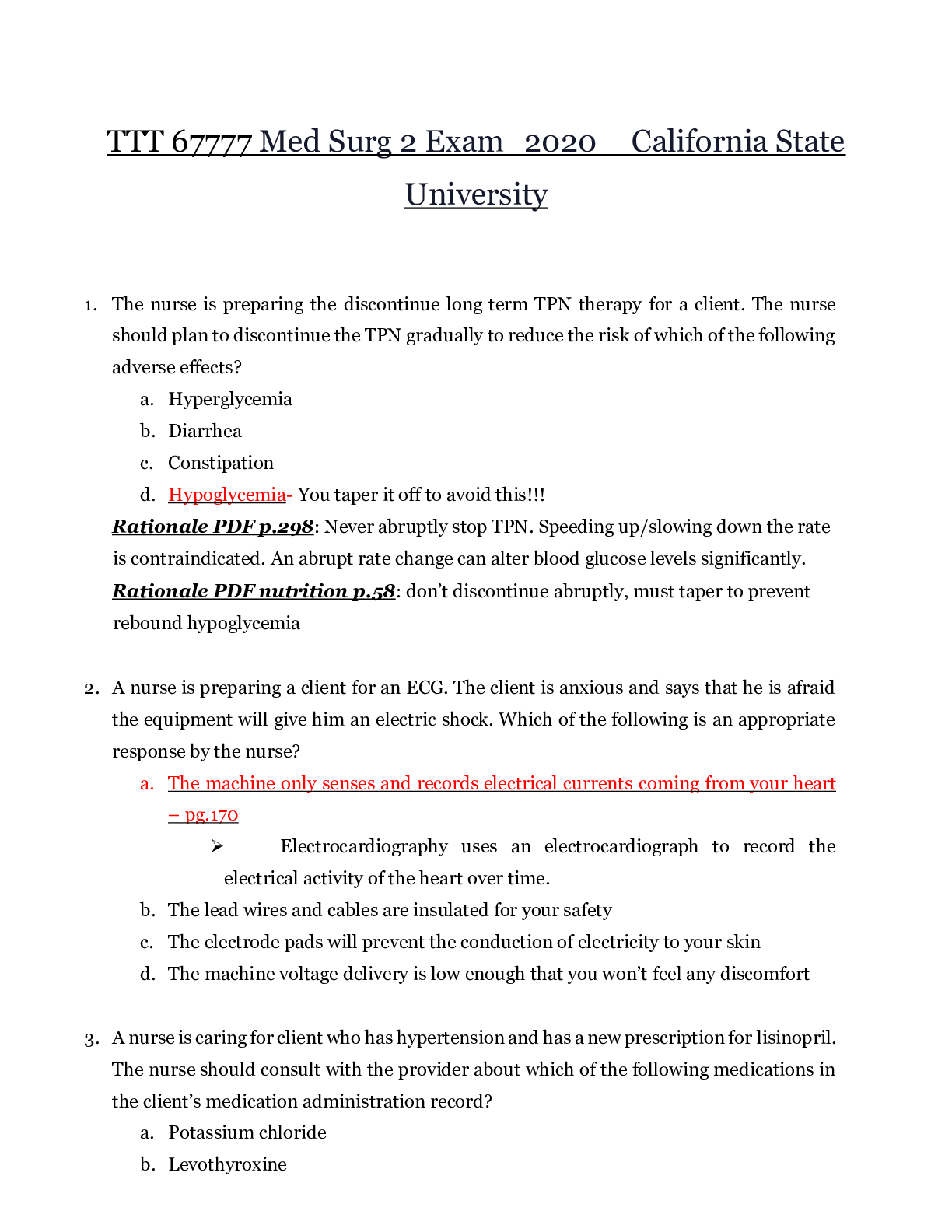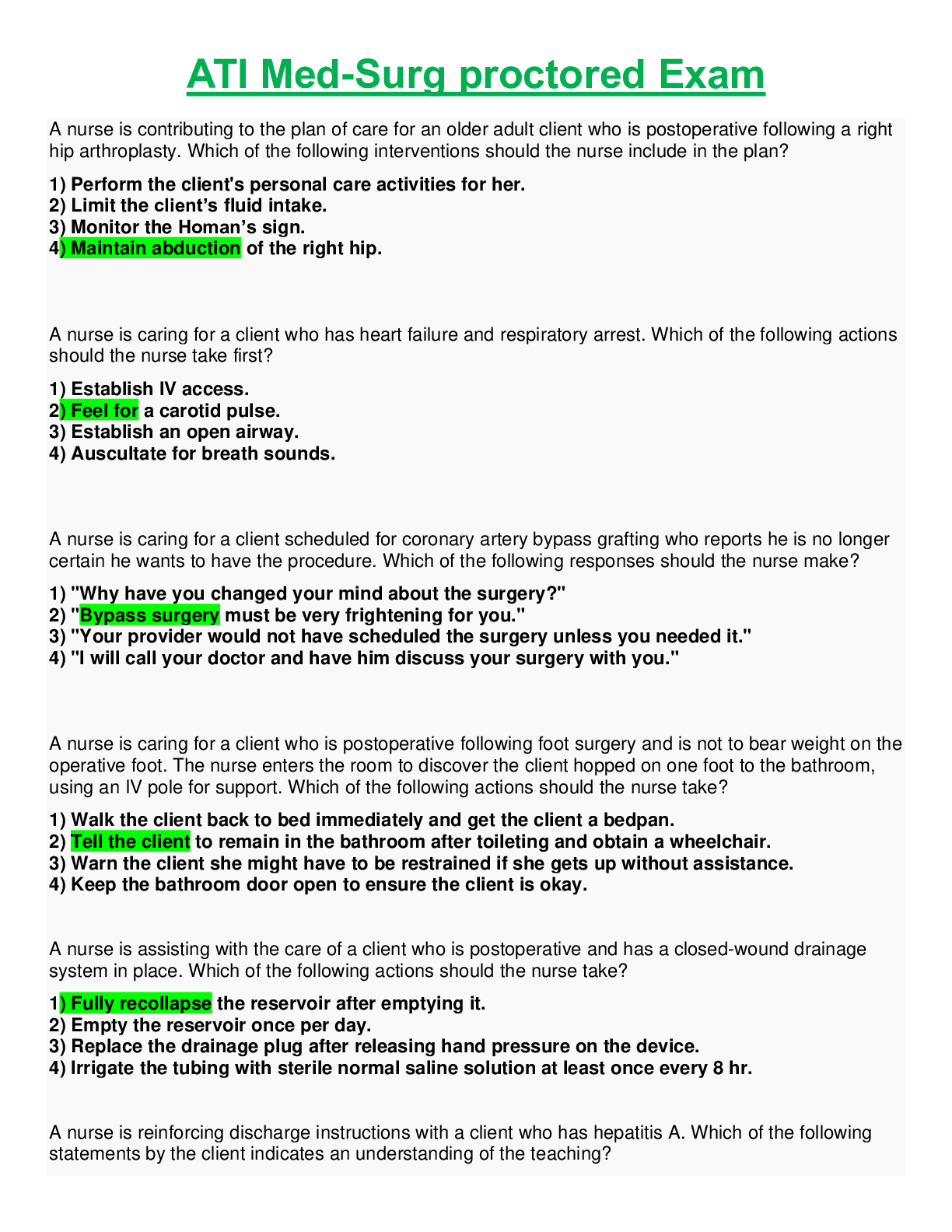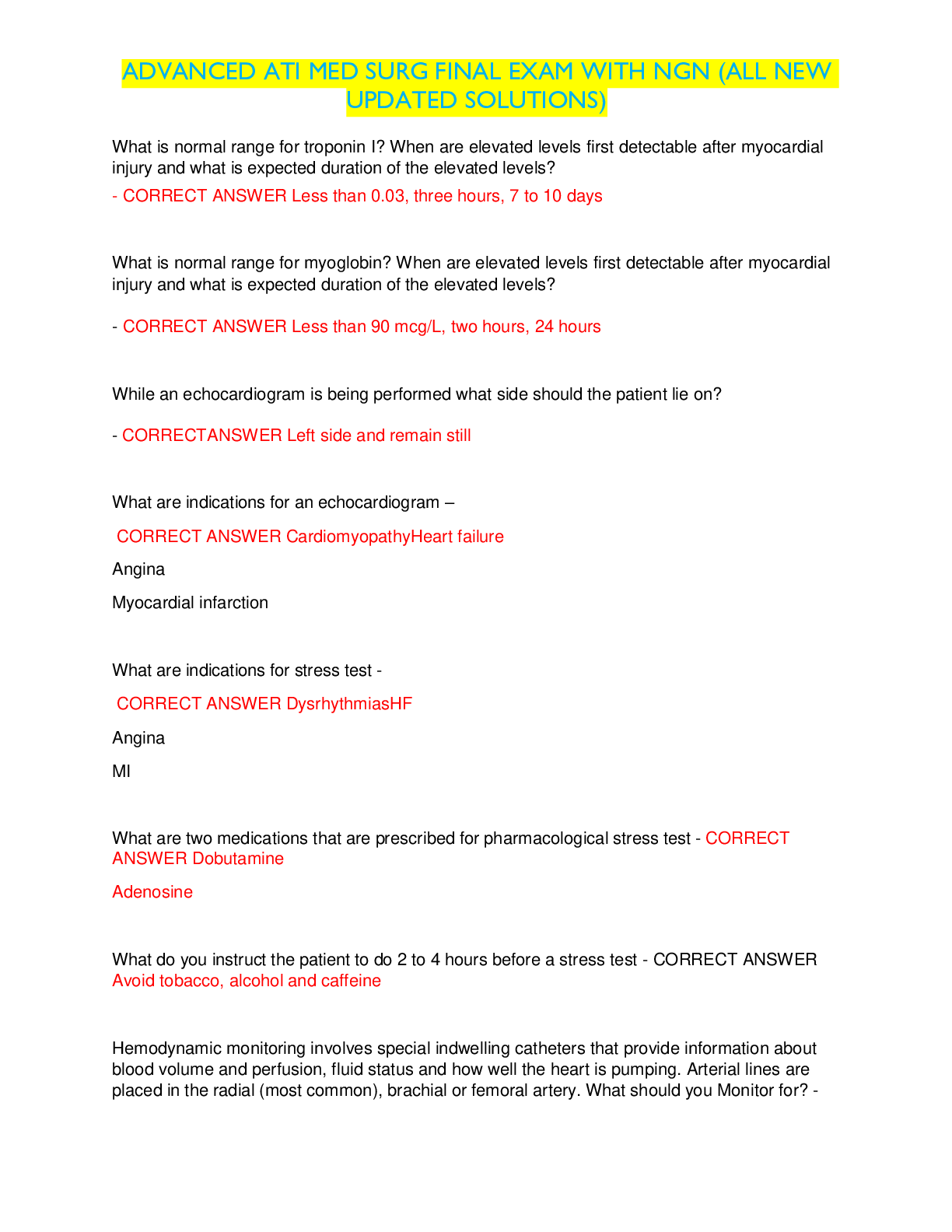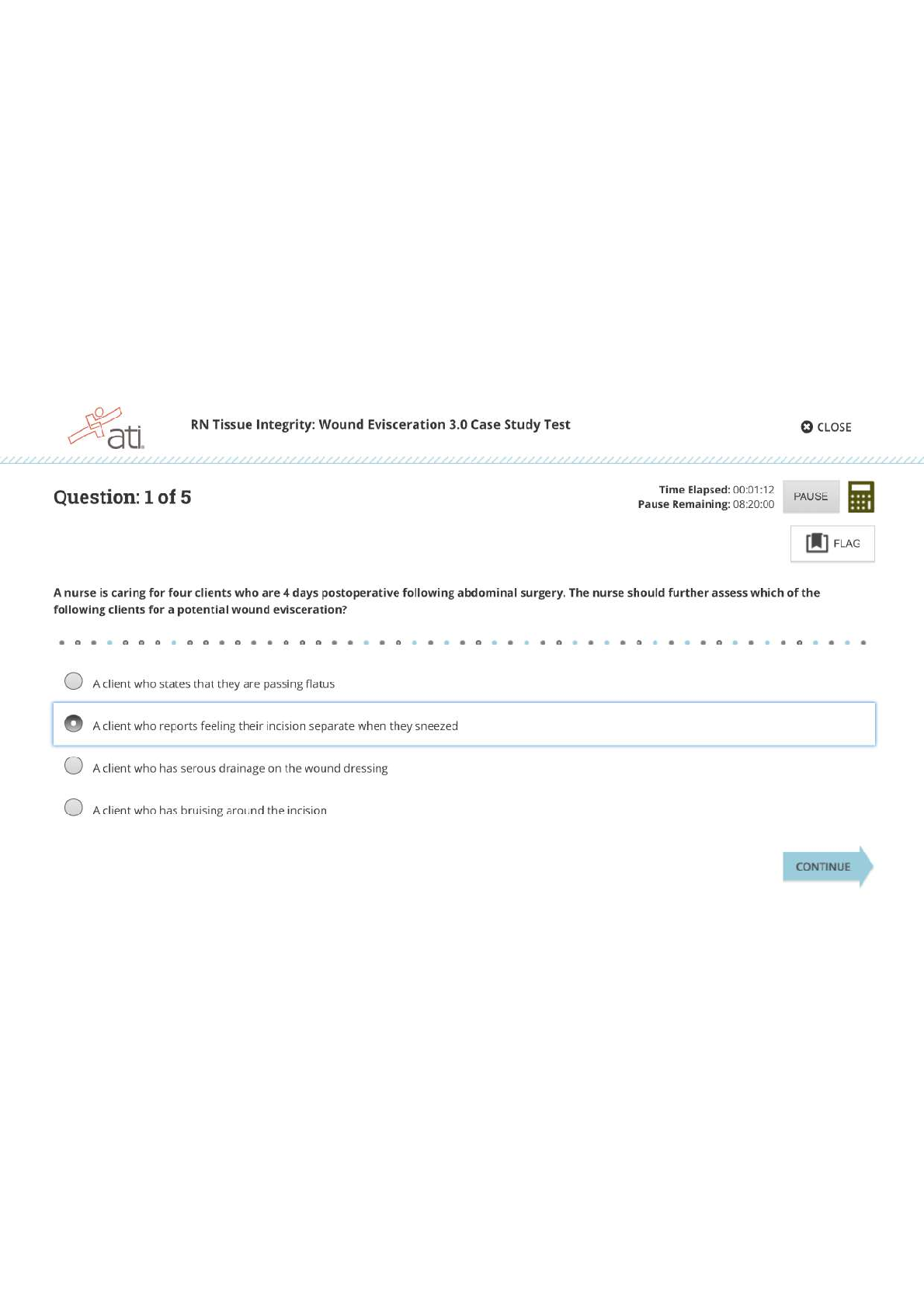*NURSING > ATI MEDICAL SURGICAL > Med Surg ATI PDF Questions And Answers( With Complete Best Solution Rated A) (All)
Med Surg ATI PDF Questions And Answers( With Complete Best Solution Rated A)
Document Content and Description Below
2. A nursing planning care for a school-age child who is 4 hrs. postoperative following perforated appendicitis. Which of the following actions should the nurse include in the plan of care? a. Offer... small amounts of clear liquids 6 hrs. following surgery (assess for gag reflex first) b. Give cromolyn nebulizer solution every 6 hrs. (for asthma) c. Apply a warm compress to the operative site every 4 hrs. d. Administer analgesics on a scheduled basis for the first 24 hrs. Rationale Fundamentals ATI PDF p229: Managing acute severe pain with short‑term (24 to 48 hrs.) around‑the‑clock administration of opioids is preferable to following a PRN schedule. ATI PEDS 144 Maintain NPO. Administer IV fluids and antibiotics as prescribed. NO cromolyn nebulizer stated on ATI. 3. A nurse is receiving change-of-shift report for a group of clients. Which of the following clients should the nurse plan to assess first? a. A client who has sinus arrhythmia and is receiving cardiac monitoring b. A client who has diabetes mellitus and a hemoglobin A1C of 6.8% c. A client who has epidural analgesia and weakness in the lower extremities d. A client who has a hip fracture and a new onset of tachypnea Rationale Med Surg ATI PDF p457: s/s of fat embolism (dyspnea, increased RR, decreased O2, headache, decreased LOC r/t low O2 levels, respiratory distress, tachycardia, confusion, chest pain), Hip and pelvis fractures are common causes, can occur after injury usually within 12-48 hrs. 4. A nurse is preparing to apply a transdermal nicotine patch for a client. Which of the following actions should the nurse take? a. Shave hairy areas of skin prior to application (apply to hairless, clean & dry areas to promote absorption; avoid oily or broken skin) b. Wear gloves to apply the patch to the client’s skin c. Apply the patch within 1 hr. of removing it from the protective pouch (apply immediately) d. Remove the previous patch and place it in a tissue (fold patch in half with sticky sides pressed together) Rationale https://medlineplus.gov/druginfo/meds/a601084.html: How to apply patch Rationale ATI Skills Module Medication Administration: Topical medications include lotions, creams, ointments, patches, and paste. Because topical medications are absorbed by the skin, wear gloves when applying them to protect yourself against accidental exposure Shaving may cause skin irritation and change the absorption of the drug.COMPREHENSIVE 3 5. A nurse has just received change-of-shift report for four clients. Which of the following clients should the nurse assess first? a. A client who was just given a glass of orange juice for a low blood glucose level b. A client who is schedule for a procedure in 1 hr. (can wait) c. A client who has 100 mL fluid remaining in his IV bag (can wait) d. A client who received a pain medication 30 min ago for postoperative pain Rationale Med Surg ATI PDF p529: assess for improvement or worsening of hypoglycemia. Repeat the administration of carbohydrates if not within normal limits, and recheck blood glucose in 15 min. Risk for seizure & coma if condition worsens. 6. A nurse is caring for a client who is receiving intermittent enteral tube feedings. Which of the following places the client at risk for aspiration? a. A history of gastroesophageal reflux disease b. Receiving a high osmolarity formula c. Sitting in a high-Fowler’s position during the feeding d. A residual of 65 mL 1hr postprandial Rationale ATI MS p309: Complications: Aspiration of gastric secretion Causes: Reflux of gastric fluids into the esophagus can be aspirated into the trachea. 7. A nurse is reviewing the laboratory results for a client who has Cushing’s disease. The nurse should expect the client to have an INCREASED in which of the following laboratory values? a. Serum glucose level- increased b. Serum calcium level-decreased c. Lymphocyte count- decreased immune system. d. Serum potassium level- decreased Rationale ATI MS PDF p518: Cushing disease→ everything is UP except Potassium & Calcium: DECREASED. 8. A nurse is caring for a client who has severe preeclampsia and is receiving magnesium sulfate intravenously. The nurse discontinues the magnesium sulfate after the client displaces toxicity. Which of the following actions should the nurse take? P . 235 pharm Ch. 30 a. Position the client supine b. Prepare an IV bolus of dextrose 5% in water c. Administer methylergonovine IM d. Administer calcium gluconate IV Rationale ATI PHARM PDF p398: Calcium gluconate is given for magnesium sulfate toxicity. Always have an injectable form of calcium gluconate available when administering magnesium sulfate by IV. 9. A charge nurse is teaching new staff members about factors that increase a client’s risk to become violent. Which of the following risk factors should the nurse include as the best predictor of future violence?COMPREHENSIVE 4 a. Experiencing delusions b. Male gender c. Previous violent behavior d. A history of being in prison Rationale ATI MH p185: Risk factors also include: history of aggression, poor impulse control, and violence. Comorbidity that leads to acts of violence (psychotic delusions, command hallucinations, violent angry reactions with cognitive disorders). Rationale ATI COMMUNITY p50: Individual Assessment for Violence 10. A nurse is preparing to perform a sterile dressing change. Which of the following actions should the nurse take when setting up the sterile field? a. Place the cap from the solution sterile side up on clean surface b. Open the outermost flap of the sterile kit toward the body→ flap AWAY from the body's first c. Place the sterile dressing within 1.25 cm (0.5in) of the edge of the sterile field → 2.5 cm (1-inch) border around any sterile drape or wrap that is considered contaminated. d. Set up the sterile field 5 cm (2 in) below waist level→ it says BELOW waist level; should be ABOVE waist level Rationale POTTER & PERRY SKILLS & TECH p187: Remove sterile seal and cap from bottle in upward motion. 11. A nurse is providing teaching to an older adult client about methods to promote nighttime sleep. Which of the following instructions should the nurse include? a. Eat a light snack before bedtime b. Stay in bed at least 1 hr. if unable to fall asleep c. Take a 1 hr. nap during the day d. Perform exercises prior to bedtime 12. A home health nurse is preparing for an initial visit with an older adult client who lives alone. Which of the following actions should the nurse take first? a. Educate the client about current medical diagnosis b. Refer the client to a meal delivery program c. Identify environmental hazards in the home d. Arrange for client transportation to follow-up appointments Rationale Priority: Assess first. 13. A nurse is assessing the remote memory of an older adult client who has mild dementia. Which of the following questions should the nurse ask the client? a. “Can you tell me who visited you today?” b. “What high school did you graduate from?” c. “Can you list your current medications?”COMPREHENSIVE 5 d. “What did you have for breakfast yesterday?” Rationale ATI How to assess “remote memory”? Have patient state a verifiable fact (e.g. birthdate). OR ask the client to state a fact from their past that is verifiable. Memory of events that occurred in the distant past. 14. A nurse is providing teaching to an adolescent who has type 1 diabetes mellitus. Which of the following goals should the nurse include in the teaching? P .528 med surg Ch. 82 a. HbA1c level greater than 8%- 6.5 - 8 is the target reference. > 8 means NON-COMPLIANT b. Blood glucose level greater than 200 mg/dL at bedtime c. Blood glucose level less than 60 mg/dL before breakfast- < 70 = HYPOGLYCEMIC d. HbA1c level less than 7% 15. A nurse is caring for a client who is receiving phenytoin for management of grand mal seizures and has a new prescription for isoniazid and rifampin. Which of the following should the nurse conclude if the client develops ataxia and incoordination? a. The client is experiencing an adverse reaction to rifampin b. The client’s seizure disorder is no longer under control d. The client is having adverse effects due to combination antimicrobial therapy Rationale: http://www.webmd.com/drugs/2/drug-4157/dilantin-oral/details#interactions Rationale ATI Pharm p96: Phenytoin complications include ataxia, sedation & cognitive impairment (http://emedicine.medscape.com/article/816447-clinical#b4 also states that this is an indication of phenytoin toxicity); According to my Davis Drug Guide book, progressive s/s of phenytoin toxicity include ataxia, nystagmus, confusion, nausea, slurred speech & dizziness. 16. A nurse is caring for a client who is 1 hr. postoperative following rhinoplasty. Which of the following manifestations requires immediate action by the nurse? a. Increase in frequency of swallowing→ may indicate bleeding b. Moderate sanguineous drainage on the drip pad c. Bruising to the face→ side effect d. Absent gag reflex→ possibly due to anesthesia given. (1 hour postoperative) Rationale “Requires immediate action” choose the worst possibility that could lead to. ABC 17. A nurse is planning care for a preschool-age child who is in the acute phase Kawasaki disease. Which of the following interventions should the nurse include in the plan of care? a. Give scheduled doses of acetaminophen every 6 hr. b. Monitor the child’s cardiac status c. Administer antibiotics via intermittent IV bolus for 24 hr. d. Provide stimulation with children of the same age in the playroom Rationale ATI PDF p: PEDS p. 120 Monitor VS, cardiac status. Maintain cardiac monitoring. Assess for HF (decrease urine output, gallop heart rhythm, tachycardia, respiratory distress)COMPREHENSIVE 6 Kawasaki disease cause inflammation in the walls of medium-sized arteries throughout the body. It primarily affects children. The inflammation tends to affect the coronary arteries, which supply blood to the heart muscle. 18. A nurse is planning an educational program for high school students about cigarette smoking. Which of the following potential consequences of smoking is most likely to discourage adolescents from using tobacco? a. Use of tobacco might lead to alcohol and drug abuse b. Smoking in adolescence increases the risk of developing lung cancer later in life c. Use of tobacco decreases the level of athletic ability d. Smoking in adolescence increases the risk of lifelong addiction Rationale ATI PDF p:33 PEDS Age appropriate activities for high school students: sports, video games, music, social events. 19. A nurse is assessing a client who is prescribed spironolactone. Which of the following laboratory values should the nurse monitor for this client? P . 146 Ch. 19 CONFIRMED a. Total bilirubin b. Urine ketones c. Serum potassium- diuretic that retains potassium= hyperkalemic risk d. Platelet count Rationale ATI PDF p: 146 Pharm Complications: hyperkalemia [Show More]
Last updated: 1 year ago
Preview 1 out of 46 pages
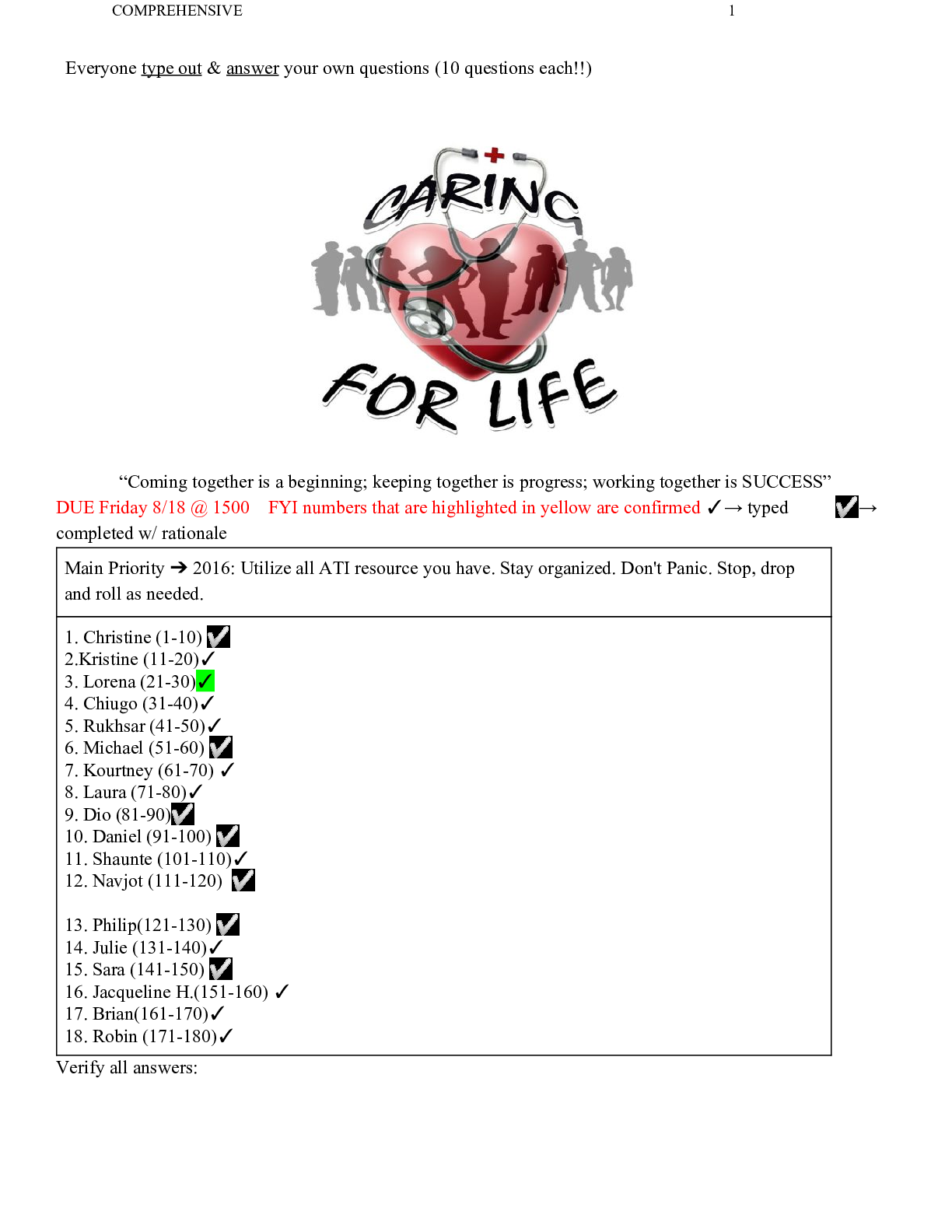
Reviews( 0 )
Document information
Connected school, study & course
About the document
Uploaded On
Jun 20, 2022
Number of pages
46
Written in
Additional information
This document has been written for:
Uploaded
Jun 20, 2022
Downloads
0
Views
111


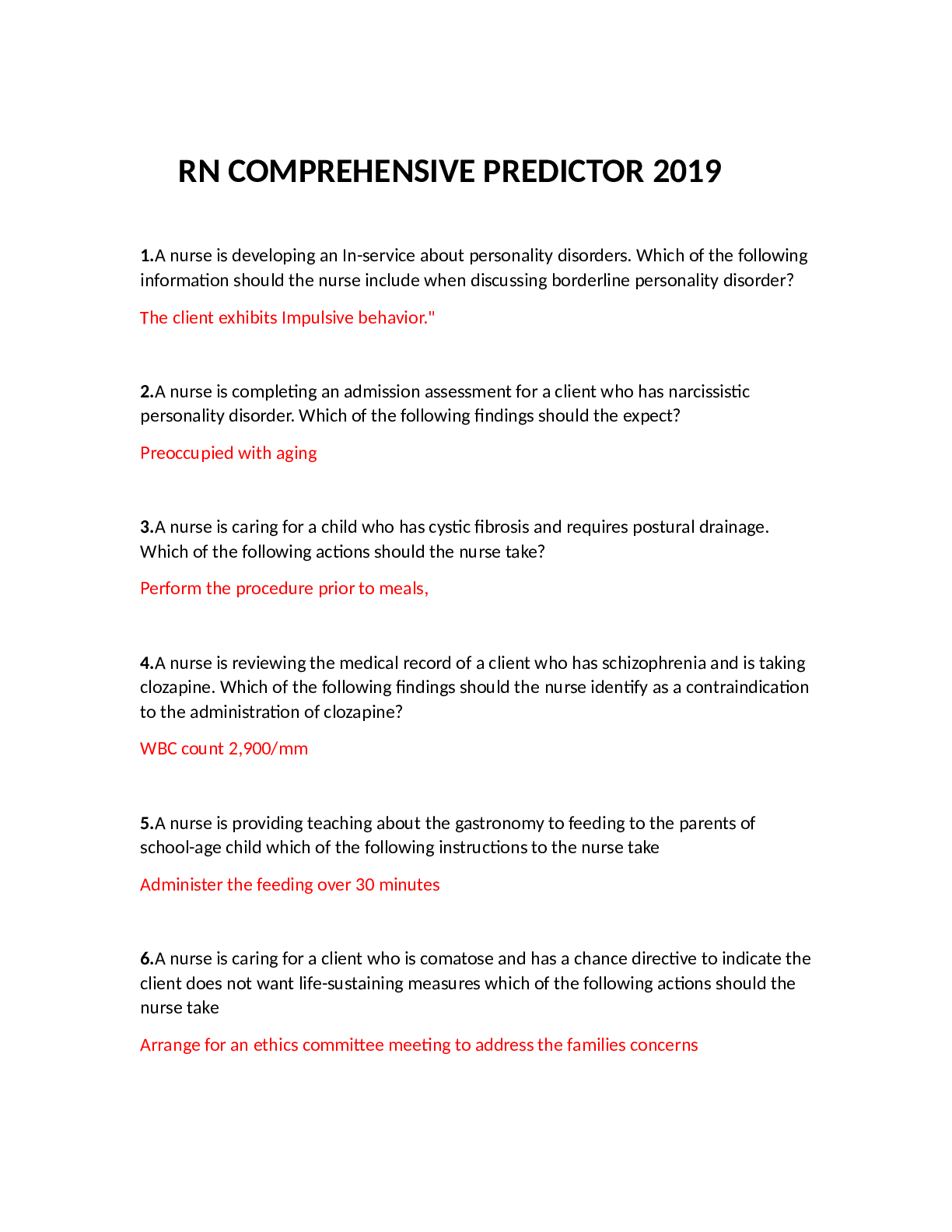
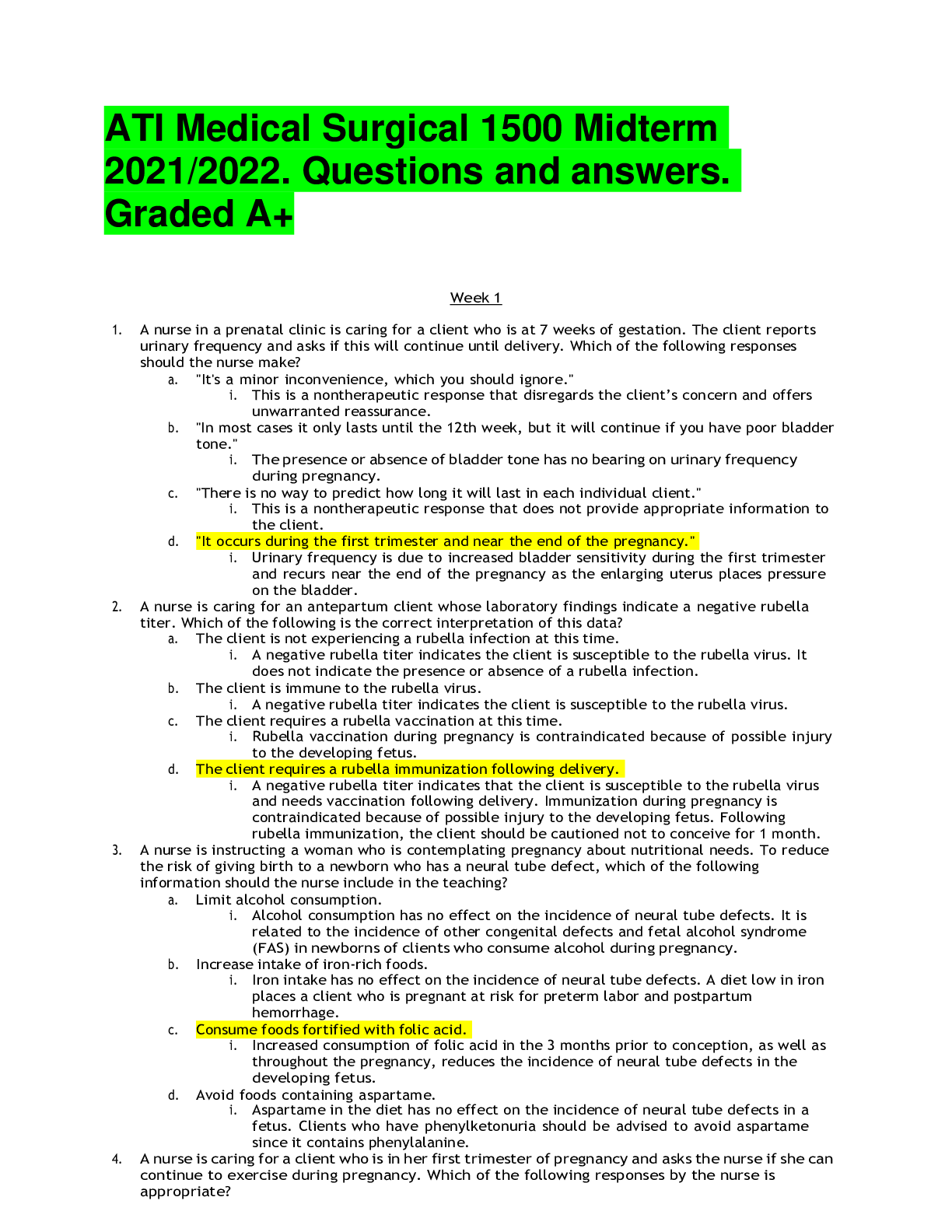


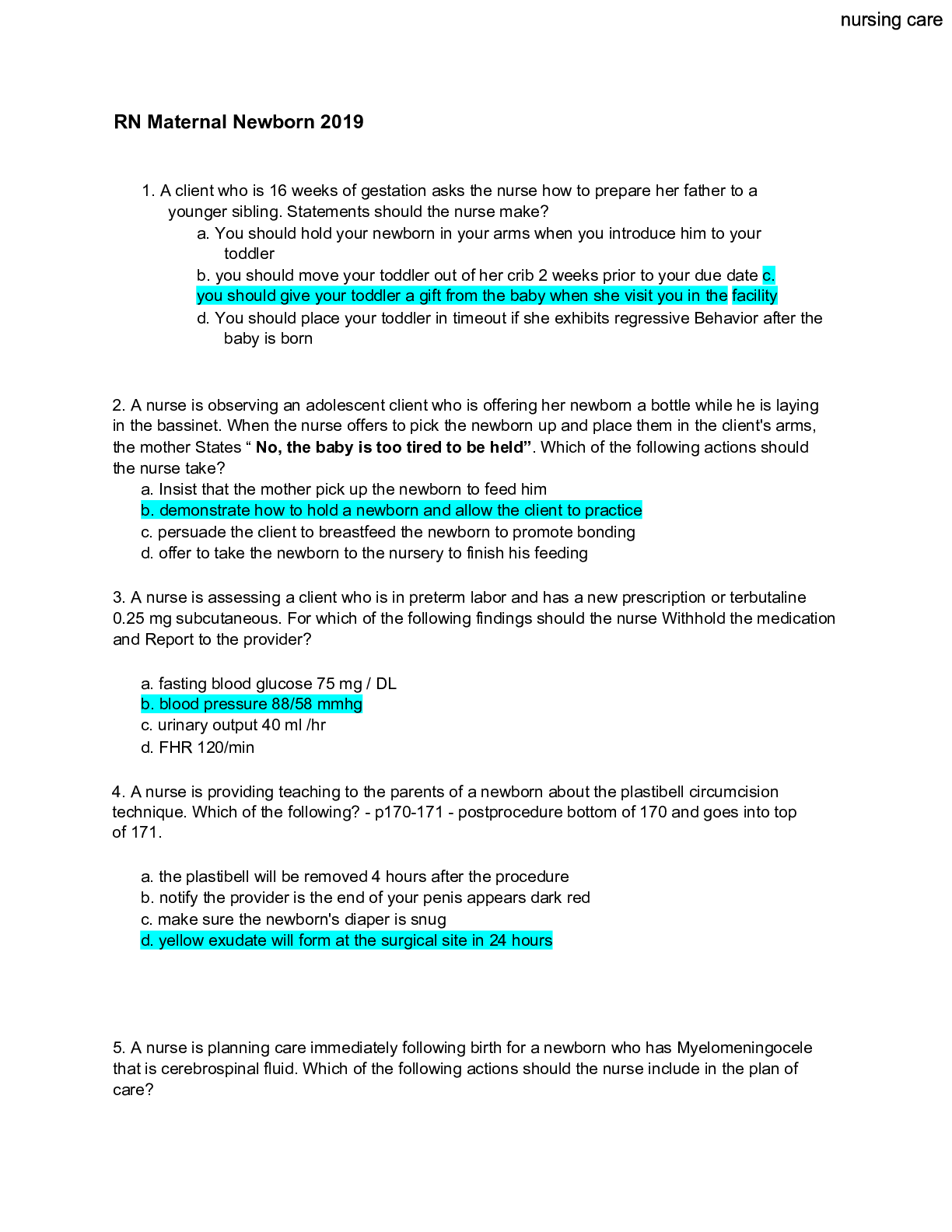


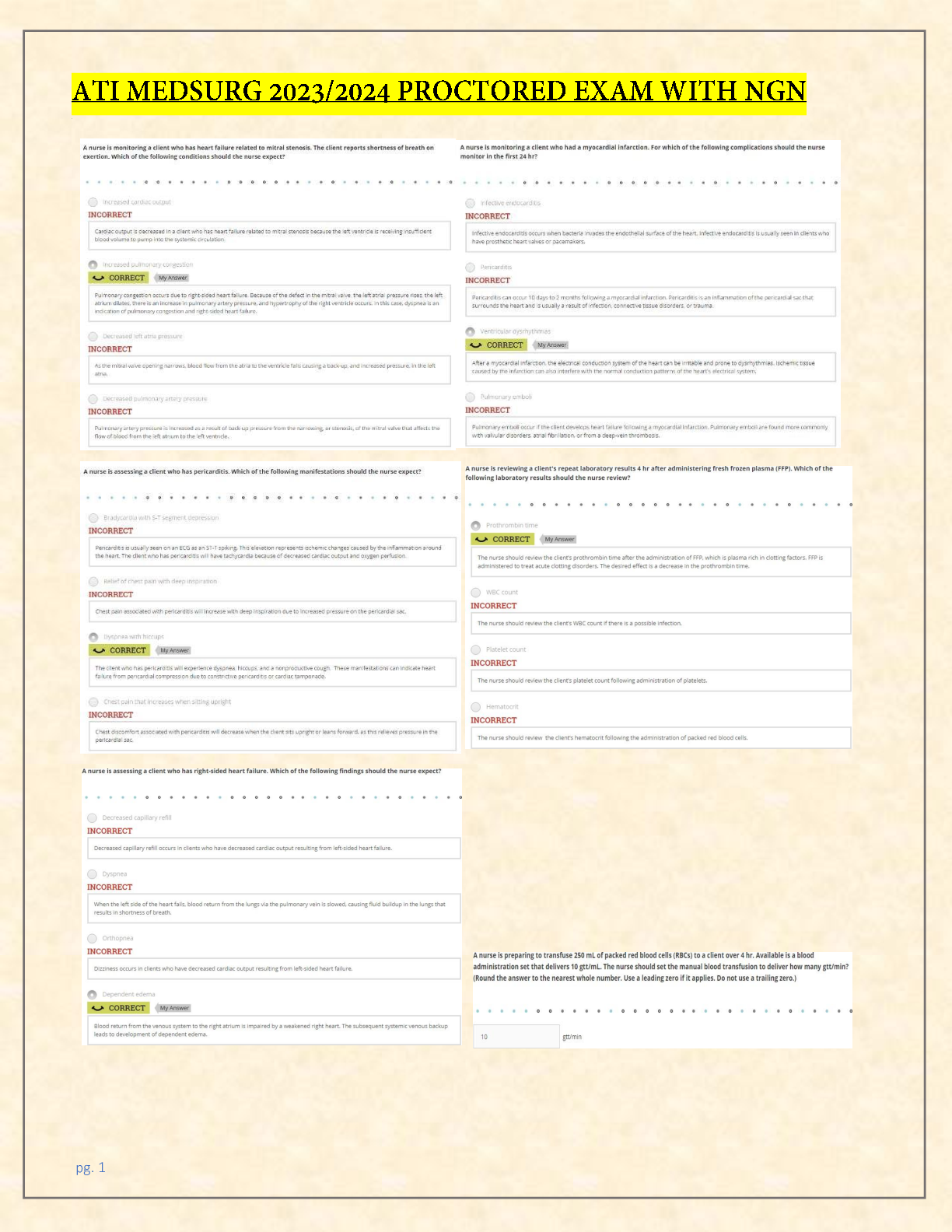
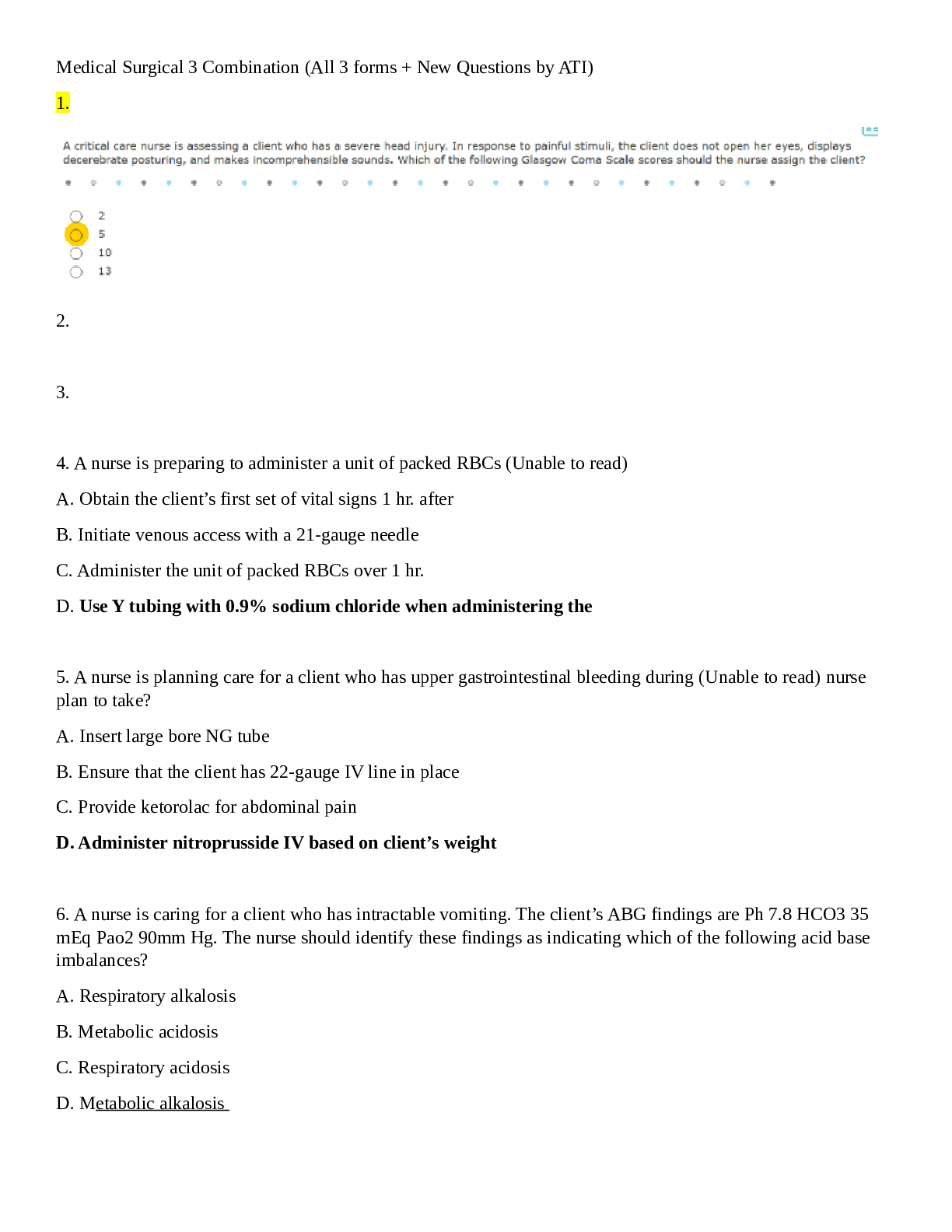
 – Chamberlain College of Nursing.png)

